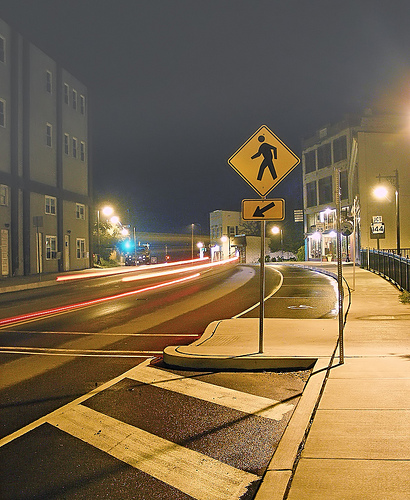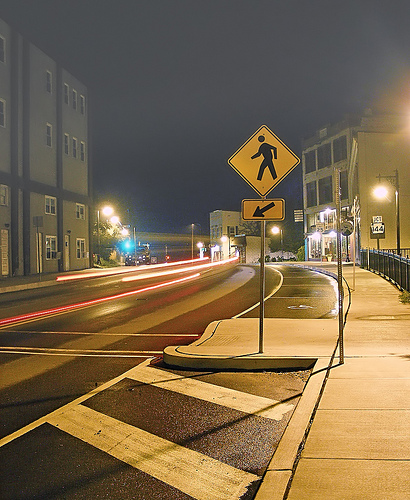 Too many American streets and roads are missing something.Photo: Nicholas_TCreating an environment where people can get across the street without being killed by a driver should be a top priority for the people who design our streets and roads, don’t you think?
Too many American streets and roads are missing something.Photo: Nicholas_TCreating an environment where people can get across the street without being killed by a driver should be a top priority for the people who design our streets and roads, don’t you think?
Sad to say, it isn’t always so. You only have to take a look at Charles Marohn’s enlightening “Confessions of a recovering engineer” to learn that. Here’s what Marohn wrote:
[T]he engineer first assumes that all traffic must travel at speed. Given that speed, all roads and streets are then designed to handle a projected volume. Once those parameters are set, only then does an engineer look at mitigating for safety and, finally, how to reduce the overall cost (which at that point is nearly always ridiculously expensive).
And one of the things that keeps cars from “traveling at speed” is crosswalks — those pesky places where pedestrians are allowed to scurry from one side of the street to the other in at least nominal safety.
Properly designed crosswalks, and the protection they can offer from death by car, are few and far between in many American communities. It may be that you live in one of those places and would like to have a crosswalk installed near where you live or work.
How the hell do you go about it?
Thanks to Katie Matchett, a pedestrian-friendly planner who writes the excellent blog Where the Sidewalk Starts, you can get some answers from a person who understands how these processes work. She is publishing a series of how-to posts designed to help citizens navigate municipal bureaucracies and make convincing arguments so that they can achieve safe pedestrian crossings in their communities. Here’s how she begins:
Step 1: Why are we doing this again?
If you’re serious about getting a crosswalk installed in your neighborhood, you need a convincing argument for installing it — and by convincing I don’t mean generic or self-serving complaints like “people in my neighborhood drive too fast” or “I hate having to walk an extra block to cross the street.” These may be legitimate problems, but remember that yours is only one of hundreds of similar requests your city receives. To make yours rise to the top you need to:
- Be polite — This can be a frustrating process, but rudeness gets you nowhere but the trash can. Letters to your city beginning “Dear pea-brains” does not further your cause (plus they get boring after a while). Along these same lines, ranting letters in ALL CAPS do not endear you to the folks whose help you need.
- Be sane — Now is not the time to bring up conspiracy theories, aliens, or explicit pictures. Ditto on the chicken/bloody corpse/traffic light costume
- Get data — Can you spend an hour counting how many people try to cross the road on a typical afternoon? Calculate how many schoolchildren use the crossing to get home? Find out the number of past crashes at your location? The more detailed information you have to demonstrate that there is a problem at your crossing, the stronger your argument becomes
- Gather support — From your neighbors, your PTA, your local pedestrian advocacy organization
Read much more here and here. The series is ongoing.
As Matchett notes in another post, there have been questions historically about just how effective crosswalks are at protecting pedestrians. In some cases, municipalities (including Los Angeles) have used those doubts to justify removing crosswalks altogether.
She has another take: Make the crosswalks better and more prominent:
I don’t dispute that in many cases marked crosswalks alone aren’t adequate to protect pedestrians. Sometimes it takes median refuges, flashing lights, raised crossings, or one of the many other solutions have have been shown to increase pedestrian safety at crossings. But the suggestion that the solution to this problem is to remove marked crosswalks?? It really twists my shoelaces into knots. Pedestrians in Los Angeles — and everywhere else — deserve more sophisticated thinking from their policymakers.
At least if you get hit by a car when crossing in a crosswalk, you probably won’t get a ticket for “careless interference with traffic” while you’re in the hospital. Because, you know, that kind of stuff really happens.


